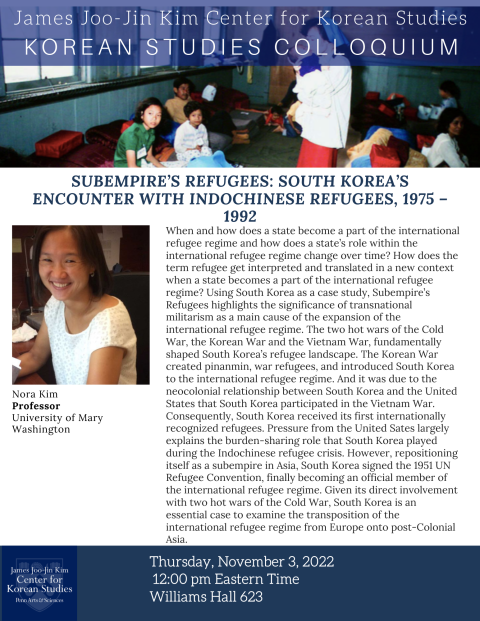
Korean Studies Colloquium
Williams Hall 623
When and how does a state become a part of the international refugee regime and how does a state’s role within the international refugee regime change over time? How does the term refugee get interpreted and translated in a new context when a state becomes a part of the international refugee regime? Using South Korea as a case study, Subempire’s Refugees highlights the significance of transnational militarism as a main cause of the expansion of the international refugee regime. The two hot wars of the Cold War, the Korean War and the Vietnam War, fundamentally shaped South Korea’s refugee landscape. The Korean War created pinanmin, war refugees, and introduced South Korea to the international refugee regime. And it was due to the neocolonial relationship between South Korea and the United States that South Korea participated in the Vietnam War. Consequently, South Korea received its first internationally recognized refugees. Pressure from the United Sates largely explains the burden-sharing role that South Korea played during the Indochinese refugee crisis. However, repositioning itself as a subempire in Asia, South Korea signed the 1951 UN Refugee Convention, finally becoming an official member of the international refugee regime. Given its direct involvement with two hot wars of the Cold War, South Korea is an essential case to examine the transposition of the international refugee regime from Europe onto post-Colonial Asia.
Nora Kim is a professor of sociology at University of Mary Washington. Her research focuses on the issues of citizenship, international migration, and multiculturalism. Her most current works have been published at positions: asia critique (forthcoming in March 2023), Journal of Refugee Studies, Critical Military Studies, Law and Society Review, and Journal of Ethnic and Migration Studies. She is currently working on a book manuscript, entitled Subempire’s Refugees: The International Refugee Regime and South Korea’s Refugee Landscape Since 1950
 James Joo-Jin Kim Center for Korean Studies
James Joo-Jin Kim Center for Korean Studies